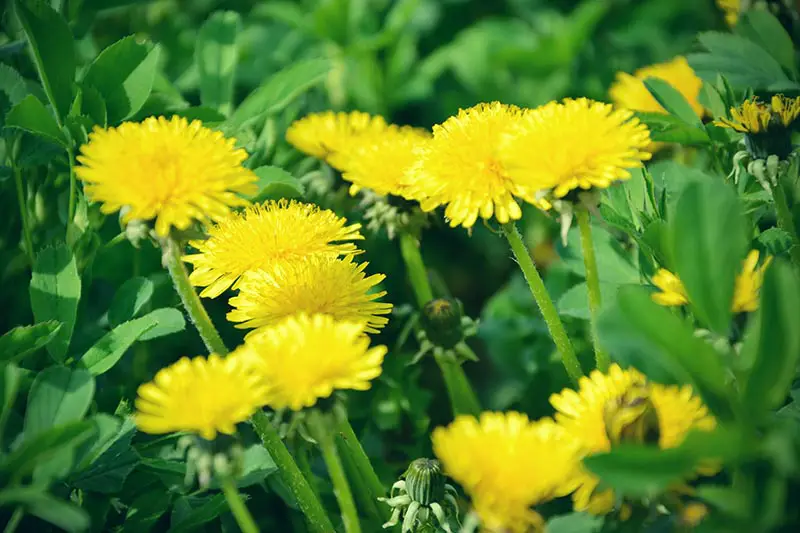Dandelions are often overlooked wildflowers, yet they provide striking yellow blooms and crucial ecological benefits. Growing dandelions intentionally allows gardeners to enjoy vibrant flowers while supporting pollinators. Their ability to thrive in various soils makes them a versatile addition to any garden. Understanding how to grow dandelions ensures consistent blooms and a healthy ecosystem.
These resilient plants produce flowers early in spring and often continue blooming intermittently throughout summer. They attract bees, butterflies, and other beneficial insects, making them essential for pollinator support. Proper planting, soil care, and seasonal maintenance allow dandelions to flourish year-round. By learning the right techniques, gardeners can balance beauty, ecological function, and sustainable growth. Dandelions become more than weeds—they enhance gardens visually and environmentally.
Understanding Dandelions and Their Growth Requirements

Dandelions are hardy perennial plants that can adapt to a wide range of soil types and climates. They grow from a deep taproot, which allows them to access water and nutrients even in less fertile soils. This adaptability makes them easy to cultivate for both aesthetic and ecological purposes. Understanding their growth requirements ensures that gardeners can provide optimal conditions for strong, vibrant blooms. Dandelions establish a rosette of leaves near the ground, which stores energy for flowering and supports the development of a deep root system crucial for long-term health.
Sunlight is another critical factor for successful growth. Dandelions thrive in full sun, which encourages photosynthesis and robust flowering. In shaded areas, plants may become leggy, producing fewer and smaller blooms. Adequate sunlight also attracts pollinators, which play a vital role in seed production and the continuation of the plant cycle. Regular observation of sunlight conditions and appropriate placement in the garden can help maximize bloom potential and overall plant vitality.
Watering and soil fertility further influence growth and flower production. While dandelions are drought-tolerant once established, consistent moisture during early growth stages promotes strong roots and healthy foliage. Nutrient-rich soils, enriched with compost or organic matter, enhance flowering and resilience. Properly balancing watering, sunlight, and soil nutrition ensures that dandelions grow vigorously, providing both beautiful blooms and sustained support for pollinators throughout the season. Understanding these requirements is the foundation for successful cultivation and a thriving garden ecosystem.
Preparing Soil for Dandelion Planting
Healthy soil is the foundation for growing vibrant dandelions. Loamy, well-drained soil provides the ideal environment for roots to penetrate deeply and access nutrients. Dandelions can tolerate a range of soil types, but compacted or clay-heavy soils may hinder root development and reduce flower production. Improving soil structure through the addition of organic compost, aged manure, or leaf mold enhances fertility, aeration, and water retention, supporting strong plant growth and prolonged blooming periods. Regularly turning in compost before planting ensures nutrients are evenly distributed, preparing the soil for vigorous dandelion establishment.
pH levels also influence dandelion growth. These plants prefer slightly acidic to neutral soils, with a pH range of 6.0 to 7.0. Testing soil before planting allows gardeners to adjust pH as needed using lime to raise acidity or sulfur to lower it. Proper pH management improves nutrient availability, helping dandelions produce lush leaves and vibrant flowers. Soil amendments not only enhance fertility but also encourage beneficial microbial activity, which supports root health and nutrient absorption, laying the groundwork for strong, sustainable plant growth.
Additionally, clearing the soil of weeds, rocks, and debris is essential for optimal dandelion establishment. Competing plants can limit access to sunlight, nutrients, and water, slowing growth and reducing flowering potential. Light tilling or hand cultivation creates a smooth, loose seedbed, making it easier for seeds to germinate and seedlings to establish. Proper soil preparation also improves drainage, reduces the risk of root rot, and allows for better root aeration. By ensuring ideal soil conditions, gardeners create a strong foundation for thriving dandelions that bloom beautifully, attract pollinators, and contribute to a sustainable and visually appealing garden.
Selecting and Sowing Dandelion Seeds
Choosing the Right Seeds
Selecting high-quality dandelion seeds is crucial for successful growth and abundant blooms. Gardeners should look for seeds from reputable suppliers that guarantee viability and purity. Some varieties are bred specifically for enhanced flowering or increased resilience, which can benefit both garden aesthetics and pollinator support. Using fresh seeds ensures higher germination rates, reducing wasted effort and time. Additionally, selecting seeds suited to your regional climate increases the chances of successful establishment and extended blooming throughout the growing season.
Proper seed selection also influences plant health. Varieties with strong disease resistance reduce the need for chemical interventions and minimize pest-related issues. Seeds from organically grown plants further promote an environmentally friendly garden. By considering factors such as local climate, soil type, and desired bloom characteristics, gardeners can make informed decisions that maximize the potential of their dandelion planting. Choosing the right seeds sets the stage for healthy plants, vibrant flowers, and a thriving ecosystem that supports pollinators and other beneficial insects.
Sowing Techniques
Correct sowing techniques ensure uniform germination and strong seedling establishment. Dandelion seeds can be sown directly into prepared soil in early spring or late fall, depending on climate. Scatter seeds evenly across the soil surface and lightly press them into the soil without burying them deeply, as they require sunlight for germination. Maintaining consistent moisture during the first few weeks promotes successful sprouting and strong root development.
Spacing is also important to prevent overcrowding. Allowing enough room between seedlings reduces competition for sunlight, nutrients, and water, encouraging larger leaves and more prolific flowering. Covering the soil with a thin layer of mulch helps retain moisture and protects seeds from birds or heavy rainfall. Proper sowing techniques, combined with attentive care during germination, lay the foundation for a dense, healthy dandelion patch that blooms beautifully and attracts pollinators, ensuring a productive and visually appealing garden space.
Watering and Sunlight Requirements
Watering Needs
Dandelions are hardy plants, but consistent watering is essential during early growth stages to establish strong roots and healthy foliage. Young seedlings require regular moisture to prevent stress and promote vigorous development. Once established, dandelions are drought-tolerant, but supplemental watering during prolonged dry spells helps maintain leaf turgor and encourages continuous flowering. Overwatering should be avoided, as soggy soil can cause root rot or fungal issues that reduce flower quality.
Proper watering techniques also influence bloom frequency. Deep, infrequent watering encourages roots to grow deeper, improving drought resilience and overall plant vigor. Shallow or irregular watering can result in weaker plants that produce fewer blooms and are more susceptible to pests. Gardeners can use a soaker hose or drip irrigation to provide consistent moisture without wetting foliage excessively. Mulching around plants further retains soil moisture, moderates soil temperature, and suppresses weeds, all of which contribute to healthier dandelions and longer blooming periods. By carefully managing water, gardeners create conditions that maximize flowering, attract pollinators, and maintain vibrant garden aesthetics.
Sunlight Requirements
Dandelions thrive in full sun, requiring at least six hours of direct sunlight daily for optimal growth and flowering. Adequate sunlight supports photosynthesis, leading to strong stems, abundant leaves, and bright yellow blooms. In shaded conditions, plants may become leggy, produce smaller flowers, and have shorter bloom periods. Gardeners should carefully select planting locations to ensure maximum light exposure throughout the day.
Seasonal variations affect sunlight intensity and duration. Early spring and late fall may have lower light levels, which can slow growth and delay flowering. Strategically placing dandelions in areas with uninterrupted sunlight during critical growth periods ensures consistent bloom production. Sunlight also enhances the plant’s ability to attract pollinators, as vibrant flowers are more visible and accessible. By prioritizing full sun exposure, gardeners can extend flowering duration, maintain plant health, and create an inviting habitat for bees, butterflies, and other beneficial insects, enhancing both the beauty and ecological value of the garden.
Fertilization and Soil Nutrition
Choosing the Right Fertilizer
Proper fertilization is essential for healthy dandelion growth and abundant blooms. Dandelions benefit from balanced fertilizers containing nitrogen, phosphorus, and potassium. Nitrogen promotes lush leaf development, phosphorus supports strong root systems and flower production, and potassium enhances overall plant resilience. Organic options, such as compost, well-rotted manure, or seaweed extract, provide nutrients gradually, improving soil structure and microbial activity. These slow-release nutrients prevent over-fertilization, which can lead to excessive leaf growth at the expense of flowering.
Selecting the right fertilizer also involves considering soil tests. Testing soil before planting helps identify nutrient deficiencies and informs precise fertilizer application. Applying nutrients in appropriate amounts ensures dandelions have the resources needed to thrive, produce vibrant blooms, and resist pests or diseases. Regular fertilization combined with proper watering and sunlight maximizes flowering potential. Gardeners who tailor their fertilization strategy to soil conditions create a sustainable environment where dandelions can flourish throughout the growing season, supporting pollinators and enhancing garden aesthetics.
Timing and Frequency of Fertilization
The timing and frequency of fertilization directly impact dandelion flowering and plant health. Early spring is the optimal time to provide nutrients, as plants emerge from dormancy and begin rapid growth. A light application of fertilizer encourages vigorous leaf development and prepares dandelions for consistent blooming. Additional feeding during the growing season helps maintain energy for repeated flowering cycles and supports the plant through periods of environmental stress, such as heat or drought.
It is important not to over-fertilize, as excessive nutrients can lead to weak stems and fewer flowers. Fertilizer should be applied when the soil is moist to improve absorption and prevent root burn. Organic mulches can also supply gradual nutrition while retaining soil moisture and reducing weed competition. By carefully timing fertilization and monitoring plant response, gardeners can sustain long-lasting blooms, support pollinators, and maintain a vibrant, healthy dandelion population that contributes to a flourishing garden ecosystem.
Pest and Disease Management
Common Pests
Dandelions are generally resilient, but several pests can impact their growth and bloom quality. Aphids are small insects that feed on plant sap, causing leaves to curl and flowers to weaken. Leaf miners tunnel into foliage, reducing photosynthesis and plant vigor. Slugs and snails can also damage leaves and flowers, particularly in damp environments. Early identification and intervention are crucial to minimize damage and maintain strong, healthy plants.
Preventive measures include monitoring plants regularly and encouraging natural predators, such as ladybugs or birds. Using physical barriers or handpicking pests can also be effective in small gardens. Maintaining plant health through proper watering, soil nutrition, and sunlight exposure enhances resistance against pest attacks. Healthy dandelions are more capable of withstanding minor infestations while continuing to bloom and support pollinators. By combining vigilance with eco-friendly control methods, gardeners can protect their dandelion patches without relying heavily on chemical pesticides.
Disease Prevention
While dandelions are hardy, diseases can still affect their growth. Fungal infections, such as powdery mildew, can appear under high humidity or poor air circulation, causing white, powdery growth on leaves. Root rot may develop in overly wet soils with poor drainage, weakening plants and reducing flowering. Leaf spot and rust fungi can also diminish aesthetic appeal and overall plant health if not managed properly.
Preventive strategies focus on creating optimal growing conditions. Planting dandelions in well-drained soil, spacing them adequately, and ensuring full sun exposure minimizes disease risk. Removing infected leaves promptly prevents the spread of pathogens. Using organic mulches and avoiding overhead watering further reduces fungal growth. Healthy, disease-free dandelions maintain vibrant blooms that attract pollinators and contribute to a thriving garden ecosystem. By prioritizing disease prevention and monitoring plant health, gardeners can enjoy long-lasting flowers and sustainable dandelion cultivation.
Seasonal Care for Dandelions
Spring Care
Spring is the most important season for dandelions, as plants emerge from dormancy and begin active growth. During this time, gardeners should focus on preparing soil, ensuring adequate sunlight, and monitoring moisture levels. Light weeding around plants reduces competition for nutrients and sunlight, while applying a balanced fertilizer encourages vigorous leaf and flower development. Early spring blooms provide crucial nectar for pollinators just coming out of winter dormancy.
Pruning or deadheading spent flowers during spring promotes continuous blooming and prevents premature seed production. Mulching around plants helps retain soil moisture and suppresses weeds, while also providing a slight insulation for roots. Regular inspection for pests, such as aphids or leaf miners, ensures that minor issues do not escalate. By dedicating attention to spring care, gardeners lay the foundation for strong, healthy dandelion growth, extended flowering periods, and vibrant blooms that attract beneficial insects. Effective spring management also supports overall plant resilience for the coming growing season.
Summer Care
During summer, dandelions continue active growth, though high temperatures and dry conditions can stress plants. Gardeners should maintain consistent soil moisture without waterlogging, as both drought and overwatering can reduce flower production. Providing deep, infrequent watering encourages strong root development and supports multiple flowering cycles throughout the season. Sunlight remains critical; ensuring full sun exposure helps maintain bloom size, stem strength, and leaf vitality.
Regular maintenance is also essential in summer. Deadheading spent flowers prolongs blooming and prevents energy diversion into seed production. Light pruning of older or damaged leaves promotes fresh growth, while monitoring for pests and diseases ensures plant health under challenging conditions. Mulching can reduce soil temperature, conserve moisture, and suppress weeds, further supporting growth. By carefully managing summer care, gardeners can extend dandelion blooms, maintain pollinator support, and create a vibrant, healthy garden environment despite seasonal heat or environmental stress.
Fall Care
Fall is a critical period for dandelions to prepare for winter dormancy. During this season, gardeners should focus on maintaining soil fertility and protecting plants from early frosts. Light fertilization with organic compost or a slow-release fertilizer encourages root growth and strengthens the plant for cold weather. Deadheading remaining flowers prevents unnecessary energy loss into seed production and ensures resources are stored in roots.
Proper watering continues to be important in fall, as dry conditions can stress plants and reduce their resilience during winter. Removing fallen leaves or debris from around dandelions helps prevent fungal infections and pest buildup. Mulching with straw, shredded leaves, or other organic material insulates the soil, maintains moisture, and protects roots from freezing temperatures. By paying attention to these fall care practices, gardeners can ensure dandelions survive winter in good health, ready to resume vigorous growth and bloom cycles in the following spring.
Winter Care
During winter, dandelions enter dormancy but still require minimal attention to survive harsh conditions. Mulching remains essential to protect the roots from frost and fluctuating temperatures. Snow cover can act as natural insulation, but in areas with limited snowfall, additional mulch layers help stabilize soil temperature and reduce freeze-thaw damage.
Winter care also involves monitoring for pests or diseases that can persist under mulch or in protected areas. Removing damaged plant material before winter prevents infections from spreading when growth resumes. While watering is usually minimal, ensuring soil does not dry out completely during unusually warm spells can improve plant survival. By providing basic winter protection, gardeners can ensure dandelions remain healthy and ready for robust growth and flowering in the upcoming spring season, maintaining continuous pollinator support and vibrant garden aesthetics.
Harvesting and Using Dandelions
Harvesting Leaves and Flowers
Dandelion leaves and flowers are edible and highly nutritious. Leaves are best harvested in early spring before flowering, when they are tender and less bitter. These young leaves can be used in salads, sautés, or teas, providing vitamins A, C, and K along with minerals like calcium and iron. Flowers are typically harvested when fully open and bright yellow, ideal for making syrups, jellies, or herbal infusions.
Proper harvesting techniques ensure continued plant health. Avoid removing more than one-third of the foliage at a time, as this allows the plant to continue photosynthesis and supports future blooms. Use clean scissors or garden shears to prevent damage to stems and reduce the risk of infection. Harvesting regularly encourages new growth and can extend the overall productivity of dandelions in the garden. By selecting the right time and method for harvesting, gardeners enjoy both culinary and ecological benefits while maintaining strong, vibrant plants.
Using Dandelions for Pollinators and Health
Dandelions play a key role in supporting pollinators such as bees, butterflies, and other beneficial insects. Their early spring blooms provide one of the first food sources for emerging pollinators, which is critical for local ecosystems. Maintaining dandelions in the garden ensures a reliable nectar and pollen supply, supporting both biodiversity and the health of other flowering plants nearby.
Beyond ecological benefits, dandelions are used for herbal remedies and natural nutrition. Leaves, flowers, and roots contain compounds that promote digestion, support liver function, and act as mild diuretics. Dandelion tea, tinctures, or salads offer a sustainable way to utilize plants that would otherwise be considered weeds. By integrating harvesting practices that support both human use and pollinator needs, gardeners can maximize the utility and ecological value of their dandelion patches, ensuring healthy, productive plants and vibrant blooms throughout the growing season.
Common Mistakes That Inhibit Dandelion Growth
Overwatering and Poor Drainage
Overwatering is a common mistake that can inhibit dandelion growth and reduce flowering. While young plants need consistent moisture, excessive water leads to waterlogged soil, which deprives roots of oxygen and promotes root rot. Poor drainage can exacerbate this problem, especially in clay-heavy soils. Gardeners may notice yellowing leaves, wilting, or stunted growth when roots are stressed by too much moisture. Even established plants can struggle to bloom if the soil remains saturated for long periods.
To prevent these issues, it is essential to monitor soil moisture carefully. Water deeply but infrequently, allowing the top layer of soil to dry slightly between watering sessions. Raised beds or amended soil with compost and sand can improve drainage and root health. Mulching helps retain just enough moisture without over-saturating the soil. Proper watering encourages deep root development, strengthens plant resilience, and supports prolonged flowering. By avoiding overwatering and ensuring good drainage, gardeners create conditions for vibrant, healthy dandelions that thrive throughout the growing season, maintain strong pollinator support, and continue to bloom abundantly.
Insufficient Sunlight
Dandelions require full sun for optimal growth and abundant blooms. Planting them in shaded areas can result in weak, leggy plants with smaller flowers or reduced flowering periods. Lack of sunlight reduces photosynthesis, leading to limited energy for flower production and overall plant health. Plants in partial shade may survive but rarely produce the bright yellow blossoms that attract pollinators. Extended periods of insufficient sunlight can also make plants more susceptible to disease and reduce seed production for future growth.
To address this mistake, gardeners should carefully select planting sites with at least six hours of direct sunlight per day. Trimming nearby trees or shrubs can improve light exposure. Positioning dandelions strategically ensures robust growth, larger leaves, and longer-lasting blooms. Full sun exposure not only supports flower production but also enhances pollinator attraction, strengthens stems, and improves leaf vitality. Ensuring plants receive enough light is essential for thriving dandelions, consistent flowering cycles, and a flourishing garden ecosystem that maintains both aesthetic appeal and ecological benefits.
Extending Dandelion Blooming and Growth
Extending the flowering period of dandelions requires consistent care and attention to environmental conditions. Regular deadheading of spent flowers encourages the plant to produce new blooms rather than diverting energy into seed production. Removing older flowers also prevents overcrowding, allowing sunlight to reach lower leaves and promoting overall plant vigor. This simple practice can significantly prolong the visible bloom period, ensuring continuous color and pollinator activity in the garden.
Soil fertility plays a major role in sustaining dandelion growth and blooms. Applying a balanced, slow-release fertilizer or incorporating organic compost provides essential nutrients that support prolonged flowering. Maintaining soil moisture is equally important. Dandelions need adequate water without over-saturating the soil. Deep watering encourages strong root development, which enhances drought tolerance and supports continuous blooming. Monitoring soil conditions and adjusting watering frequency based on seasonal changes can help maintain healthy, vibrant plants throughout the growing season.
Additionally, optimal sunlight exposure maximizes flower production. Dandelions grown in full sun produce larger and more frequent blooms, attracting pollinators such as bees and butterflies. Removing weeds and minimizing competition further improves light and nutrient availability. By combining proper maintenance, soil enrichment, and strategic placement, gardeners can extend the blooming period, ensure healthy growth, and maintain a vibrant, pollinator-friendly garden. With careful attention to these practices, dandelions provide long-lasting aesthetic and ecological benefits, enhancing both the beauty and productivity of the garden throughout the season.
FAQ About How to Grow Dandelions
When is the best time to plant dandelions?
The best time to plant dandelions is early spring or late fall. These periods offer cooler temperatures and consistent soil moisture, which encourage strong germination. Planting during these windows helps young seedlings establish healthy roots and produce abundant blooms throughout the growing season, ensuring a successful and sustainable garden.
How often should I water dandelions?
Dandelions need regular watering during early growth, typically once or twice a week, depending on rainfall. Established plants are drought-tolerant but benefit from deep, infrequent watering. Proper watering promotes strong roots, healthy leaves, and continuous flowering, while overwatering can lead to root rot and reduced bloom quality.
Can dandelions grow in shaded areas?
Dandelions prefer full sun for optimal growth and flowering. In shaded areas, plants may become leggy, produce fewer flowers, and have weaker stems. While they can survive partial shade, blooms are limited, and pollinator attraction decreases. For the best results, plant dandelions in areas with at least six hours of direct sunlight.
How can I extend the flowering season of dandelions?
To extend dandelion blooming, regularly deadhead spent flowers and maintain proper soil fertility with compost or slow-release fertilizer. Ensure consistent moisture and full sunlight exposure. Removing weeds and monitoring for pests also supports extended blooms. These practices encourage new flower production and help maintain a vibrant, pollinator-friendly garden.
Are dandelions safe to eat and use?
Yes, dandelions are edible and highly nutritious. Leaves, flowers, and roots can be used in salads, teas, and herbal remedies. Young leaves are tender and less bitter, while flowers provide flavor and color. Dandelions offer vitamins, minerals, and natural compounds that support digestion, liver health, and overall wellness when consumed responsibly.
Conclusion
Dandelions are more than common garden plants; they offer vibrant blooms, ecological benefits, and edible value. Understanding their growth requirements, from soil preparation and sunlight to proper watering and fertilization, ensures healthy plants that attract pollinators and thrive season after season. Avoiding common mistakes, such as overwatering or insufficient light, and practicing careful seasonal care extends flowering and enhances plant resilience. By following these guidelines, gardeners can cultivate dandelions successfully, creating a visually appealing and environmentally supportive garden. With proper attention, dandelions provide lasting beauty, nutrition, and ecological value throughout the year.






